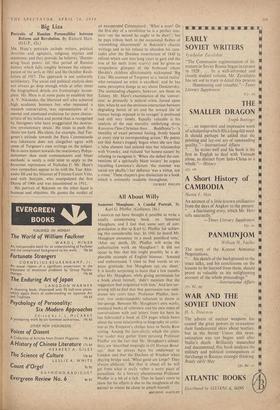Big Liza
Portraits of and Personalities between
Reform and Revolution. By Richard Hare. (O.U.P., 42s.)
MR. HARE'S portraits .include writers, political theorists and agitators, religious mystics and statesmen, and they provide, he believes, `illumin- ating focal points' for that period of Russian history which falls roughly between the emanci- pation of the serfs in 1861 and the October Revb- Intim of 1917. The approach is not uniformly satisfactory. The social and political analysis does not always go deep enough while at other times the biographical details are frustratingly incom- plete. Mr. Hare is at some pains to establish that A. V. Nikitenko, the liberated serf who achieved high academic honours but who remained a staunch conswvative, was representative of 'a mental and emotional evolution far more charac- teristic of his milieu. and period than is recognised by foreigners who have exaggerated the destruc- tive revolutionary strain.' He tends to, push this thesis too hard. His claim, for example, that Tur- genev's attitude towards the Paris Communards was lukewarm does not altogether agree with some of Turgenev's own writings on the subject. He.is more lenient towards the reactionary Pobye- donostsev than most commentators and 'blunt methods' is surely a mild term to apply to the ferocious repressions of Nicholas 1! Mr. Hare's own sympathies appear to lie with the Tsar Alex- ander Ill and his Minister of Finance Count Vitte, and with Stolypin, who manipulated the first Duma of 1906 and was assassinated in 1911.
His portrait of Bakunin on the other hand is humane and objective. He quotes the verdict of
an exasperated Communard: 'What a man! bn the first day of a revolution he is a perfect trea- sure—on the second he ought to be shot!'; but he pays tribute both to the occasional flashes of `astonishing discernment' in Bakunin's chaotic writings and to his refusal to abandon his com- rades after the Dresden insurrection of 1848 (a refusal which cost him long years in gaol and the loss of his teeth from scurvy) and he gives us sympathetic glimpses of the firebrand whom Herzen's children affectionately nicknamed 'Big Liza.' His account of Turgenev as a `social realist' who remained an artist is excellent; and he has some perceptive things to say about Dostoievsky. The outstanding chapters, however, are those on Tolstoy. Mr. Hare's, examination of the 'conver- sion' as primarily `a natural crisis, forced upon him, when he saw the ominous interaction between degrading forms of art and the inward life of human beings exposed to its ravages' is profound and still very timely. Equally valuable is his analysis of the real morality underlying Anna Rarenina (less Christian than ... Buddhistic)—`a morality of exact personal feeling, firmly bound at every step to corresponding action.' He points out that Anna's tragedy began when she saw that a false element had entered into her relationship with Vronsky, and violated 'her honest nature' by refusing to recognise it. 'When she defied the con- ventions of a spiritually blunt society' he argues (recalling Lawrence's dictum 'the monster was social not phallic') her defiance `was a virtue, not a crime.' These chapters give distinction to a book which is eminently readable throughout.
GILBERT PHELPS






































 Previous page
Previous page